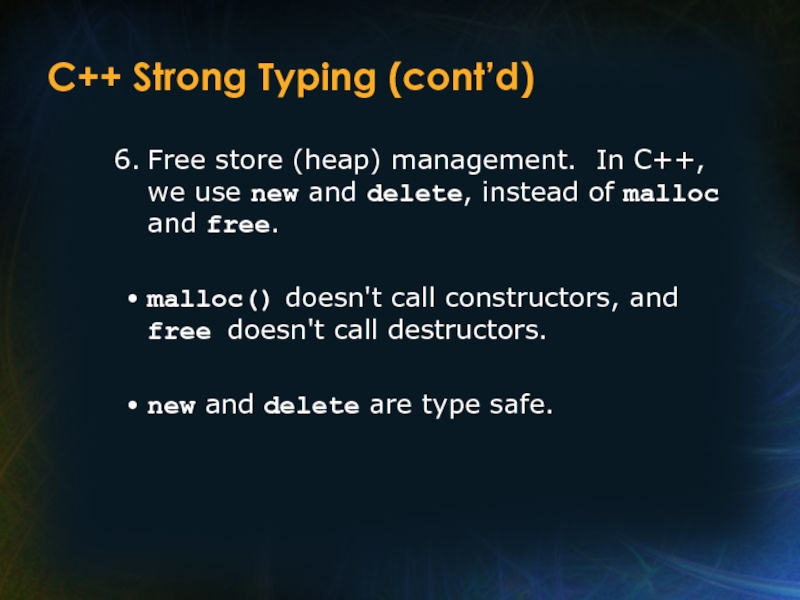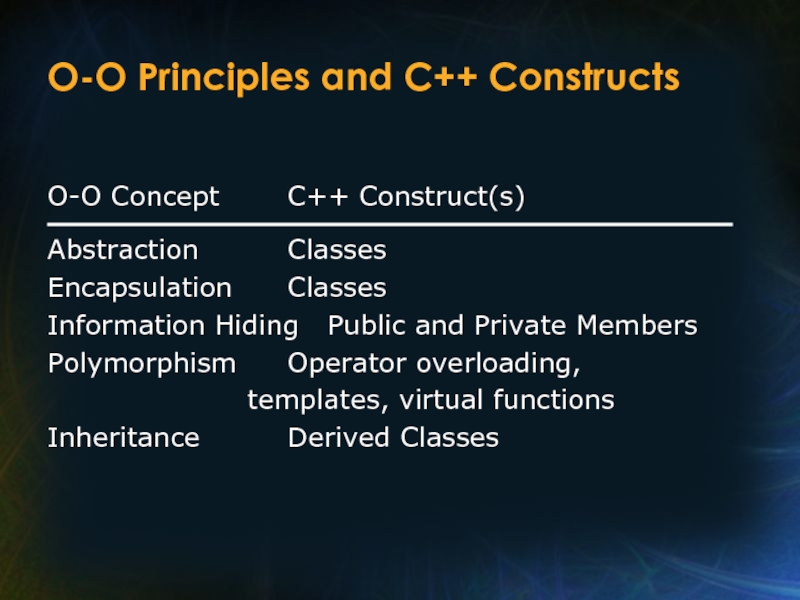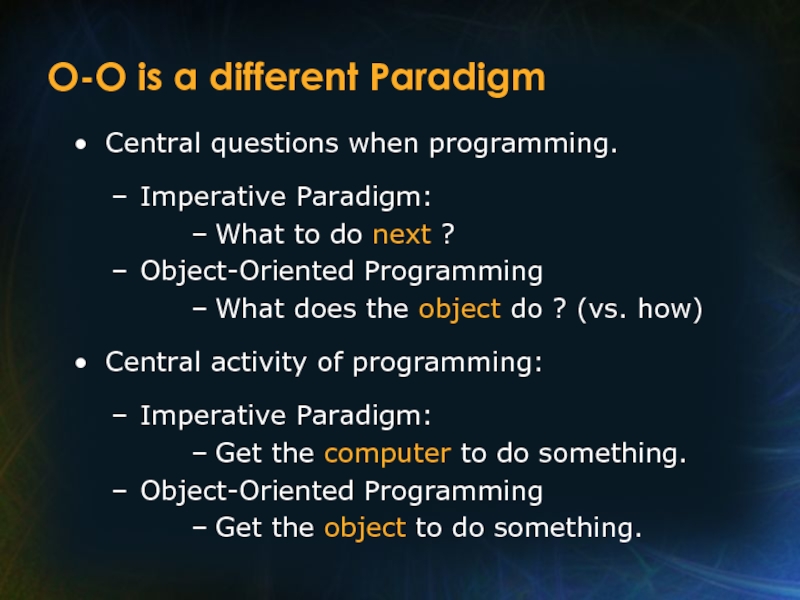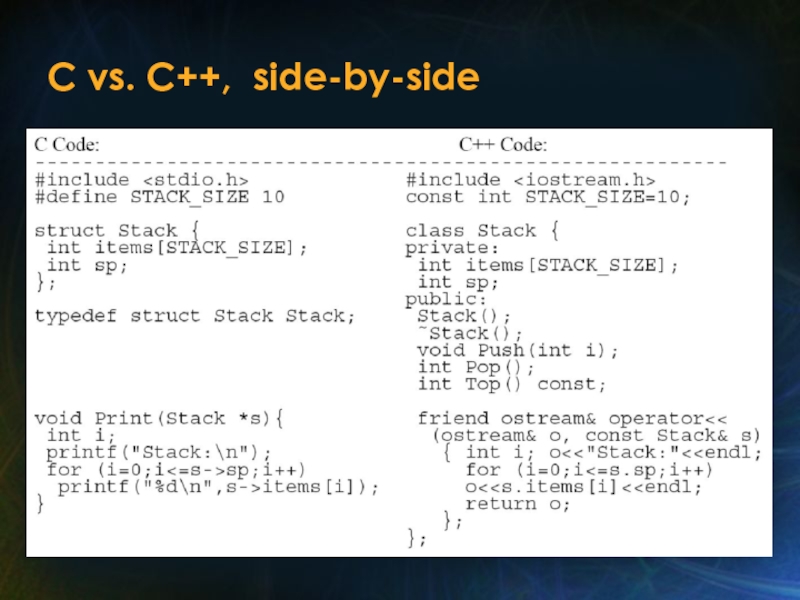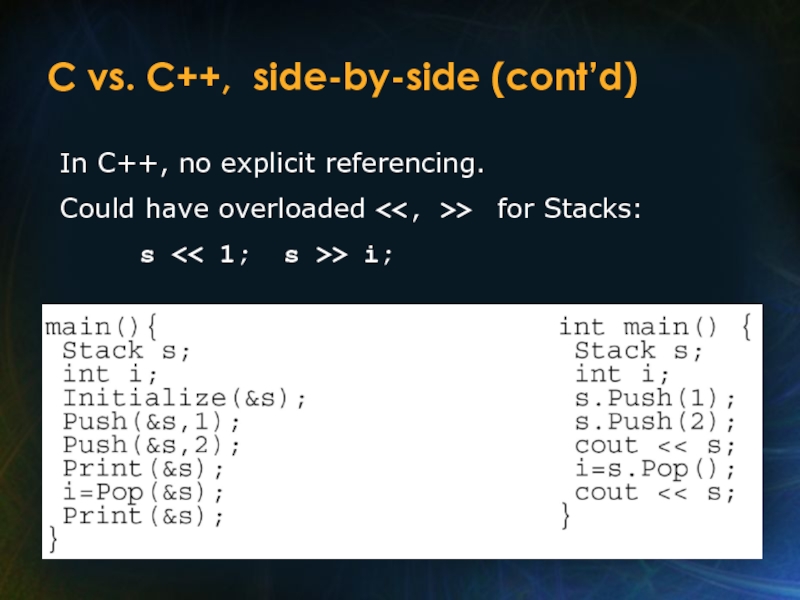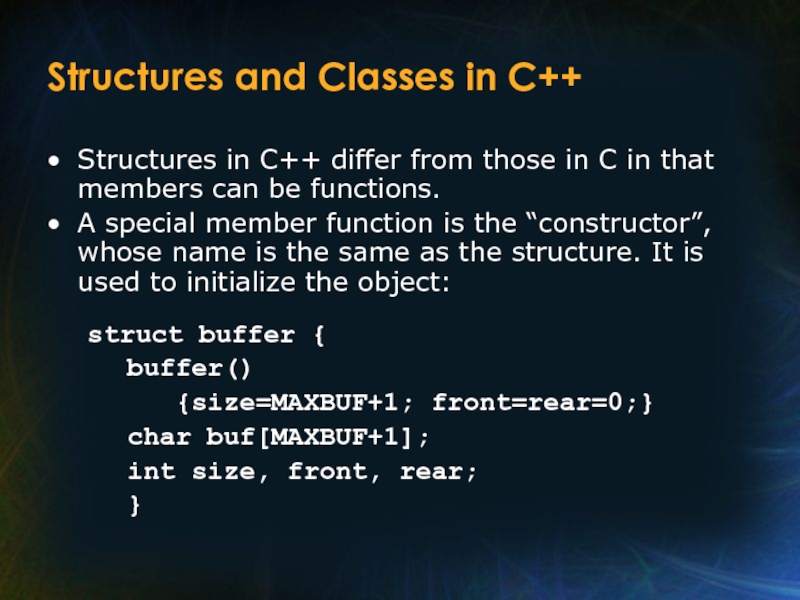Programming
- Главная
- Разное
- Дизайн
- Бизнес и предпринимательство
- Аналитика
- Образование
- Развлечения
- Красота и здоровье
- Финансы
- Государство
- Путешествия
- Спорт
- Недвижимость
- Армия
- Графика
- Культурология
- Еда и кулинария
- Лингвистика
- Английский язык
- Астрономия
- Алгебра
- Биология
- География
- Детские презентации
- Информатика
- История
- Литература
- Маркетинг
- Математика
- Медицина
- Менеджмент
- Музыка
- МХК
- Немецкий язык
- ОБЖ
- Обществознание
- Окружающий мир
- Педагогика
- Русский язык
- Технология
- Физика
- Философия
- Химия
- Шаблоны, картинки для презентаций
- Экология
- Экономика
- Юриспруденция
Object-Oriented Programming презентация
Содержание
- 1. Object-Oriented Programming
- 2. Object Oriented Programming Over time, data
- 3. Object Oriented Programming A methodology of programming
- 4. The C++ language An object-oriented, general-purpose programming
- 5. Design Objectives in C++ Compatibility. Existing code
- 6. Non Object-Oriented Extensions to C Major improvements
- 7. Stream I/O in C++ Input and output
- 8. Example of Stream I/O in C++ A
- 9. Example of Stream I/O in C++ Example
- 10. Line-by-line textfile concatenation int ch;
- 11. Why use I/O streams ? Streams are
- 12. Why use I/O streams ? (cont’d) Streams
- 13. C++ Strong Typing There are 6 principal
- 14. C++ Strong Typing (cont’d) In C, it's
- 15. C++ Strong Typing (cont’d) A C function,
- 16. C++ Strong Typing (cont’d) In C, assigning
- 17. C++ Strong Typing (cont’d) C++ is more
- 18. C++ Strong Typing (cont’d) Free store (heap)
- 19. Object-Oriented Programming Object-oriented programming is a programming
- 20. O-O Principles and C++ Constructs O-O
- 21. O-O is a different Paradigm Central questions
- 22. C vs. C++, side-by-side
- 23. C vs. C++, side-by-side (cont’d) In C++,
- 24. C vs. C++, side-by-side (cont’d) In C++,
- 25. Structures and Classes in C++ Structures in
- 26. Structures and Classes in C++ The idea
- 27. Structures and Classes in C++ The definition
- 28. Public and Private Members Structures and classes
- 29. Header File Partitioning
- 30. Header File Partitioning (cont’d)
- 31. Header File Partitioning (cont’d)
- 32. Programming Language Principles Lecture 30 Prepared by
Слайд 1Programming Language Principles
Lecture 30
Prepared by
Manuel E. Bermúdez, Ph.D.
Associate Professor
University of Florida
Object-Oriented
Слайд 2Object Oriented Programming
Over time, data abstraction has become essential as programs
became complicated.
Benefits:
1. Reduce conceptual load (minimum detail).
2. Fault containment.
3. Independent program components.
(difficult in practice).
Code reuse possible by extending and refining abstractions.
Benefits:
1. Reduce conceptual load (minimum detail).
2. Fault containment.
3. Independent program components.
(difficult in practice).
Code reuse possible by extending and refining abstractions.
Слайд 3Object Oriented Programming
A methodology of programming
Four (Five ?) major principles:
Data Abstraction.
Encapsulation.
Information
Hiding.
Polymorphism (dynamic binding).
Inheritance. (particular case of polymorphism ?)
Will describe these using C++, because ...
Polymorphism (dynamic binding).
Inheritance. (particular case of polymorphism ?)
Will describe these using C++, because ...
Слайд 4The C++ language
An object-oriented, general-purpose programming language, derived from C (C++
= C plus classes).
C++ adds the following to C:
Inlining and overloading of functions.
Default argument values.
Argument pass-by-reference.
Free store operators new and delete, instead of malloc() and free().
Support for object-oriented programming, through classes, information hiding, public interfaces, operator overloading, inheritance, and templates.
C++ adds the following to C:
Inlining and overloading of functions.
Default argument values.
Argument pass-by-reference.
Free store operators new and delete, instead of malloc() and free().
Support for object-oriented programming, through classes, information hiding, public interfaces, operator overloading, inheritance, and templates.
Слайд 5Design Objectives in C++
Compatibility. Existing code in C can be used.
Even existing, pre-compiled libraries can be linked with new C++ code.
Efficiency. No additional cost for using C++. Overheadof function calls is eliminated where possible.
Strict type checking. Aids debugging, allows generation of efficient code.
C++ designed by Bjarne Stroustrup of Bell Labs (now at TAMU).
Standardization: ANSI, ISO.
Efficiency. No additional cost for using C++. Overheadof function calls is eliminated where possible.
Strict type checking. Aids debugging, allows generation of efficient code.
C++ designed by Bjarne Stroustrup of Bell Labs (now at TAMU).
Standardization: ANSI, ISO.
Слайд 6Non Object-Oriented Extensions to C
Major improvements over C.
Stream I/O.
Strong typing.
Parameter passing
by reference.
Default argument values.
Inlining.
We’ve discussed some of these already.
Default argument values.
Inlining.
We’ve discussed some of these already.
Слайд 7Stream I/O in C++
Input and output in C++ is handled by
streams.
The directive #include declares 2 streams: cin and cout.
cin is associated with standard input. Extraction: operator>>.
cout is associated with standard output. Insertion: operator<<.
In C++, input is line buffered, i.e. the user must press before any characters are processed.
The directive #include
cin is associated with standard input. Extraction: operator>>.
cout is associated with standard output. Insertion: operator<<.
In C++, input is line buffered, i.e. the user must press
Слайд 8Example of Stream I/O in C++
A function that returns the sum
of
the numbers in the file Number.in
int fileSum();
{
ifstream infile("Number.in");
int sum = 0;
int value;
//read until non-integer or
while(infile >> value)
sum = sum + value;
return sum;
}
the numbers in the file Number.in
int fileSum();
{
ifstream infile("Number.in");
int sum = 0;
int value;
//read until non-integer or
while(infile >> value)
sum = sum + value;
return sum;
}
Слайд 9Example of Stream I/O in C++
Example 2: A function to copy
myfile into copy.myfile
void copyfile()
{
ifstream source("myfile");
ofstream destin("copy.myfile");
char ch;
while (source.get(ch))
destin<}
void copyfile()
{
ifstream source("myfile");
ofstream destin("copy.myfile");
char ch;
while (source.get(ch))
destin<
Слайд 10Line-by-line textfile concatenation
int ch;
// Name1, Name2, Name3
are strings
ifstream f1 (Name1);
ifstream f2 (Name2);
ofstream f3 (Name3);
while ((ch = f1.get())!=-1 )
if (ch =='\n')
while ((ch = f2.get())!=-1) {
f3.put(ch);
if (ch == '\n') break;
}
else f3.put(ch);
}
ifstream f1 (Name1);
ifstream f2 (Name2);
ofstream f3 (Name3);
while ((ch = f1.get())!=-1 )
if (ch =='\n')
while ((ch = f2.get())!=-1) {
f3.put(ch);
if (ch == '\n') break;
}
else f3.put(ch);
}
Слайд 11Why use I/O streams ?
Streams are type safe -- the type
of object being I/O'd is known statically by the compiler rather than via dynamically tested '%' fields.
Streams are less error prone:
Difficult to make robust code using printf.
Streams are faster: printf interprets the language of '%' specs, and chooses (at runtime) the proper low-level routine. C++ picks these routines statically based on the actual types of the arguments.
Streams are less error prone:
Difficult to make robust code using printf.
Streams are faster: printf interprets the language of '%' specs, and chooses (at runtime) the proper low-level routine. C++ picks these routines statically based on the actual types of the arguments.
Слайд 12Why use I/O streams ? (cont’d)
Streams are extensible -- the C++
I/O mechanism is extensible to new user-defined data types.
Streams are subclassable -- ostream and istream (C++ replacements for FILE*) are real classes, and hence subclassable. Can define types that look and act like streams, yet operate on other objects. Examples:
A stream that writes to a memory area.
A stream that listens to external port.
Streams are subclassable -- ostream and istream (C++ replacements for FILE*) are real classes, and hence subclassable. Can define types that look and act like streams, yet operate on other objects. Examples:
A stream that writes to a memory area.
A stream that listens to external port.
Слайд 13C++ Strong Typing
There are 6 principal situations in which C++ has
stronger typing than C.
The empty list of formal parameters means "no arguments" in C++.
In C, it means "zero or more arguments", with no type checking at all. Example:
char * malloc();
The empty list of formal parameters means "no arguments" in C++.
In C, it means "zero or more arguments", with no type checking at all. Example:
char * malloc();
Слайд 14C++ Strong Typing (cont’d)
In C, it's OK to use an undefined
function; no type checking will be performed. In C++, undefined functions are not allowed.
Example:
main()
f( 3.1415 );
// C++: error, f not defined
// C: OK, taken to mean int f()
Example:
main()
f( 3.1415 );
// C++: error, f not defined
// C: OK, taken to mean int f()
Слайд 15C++ Strong Typing (cont’d)
A C function, declared to be value-returning, can
fail to return a value. Not in C++. Example:
double foo() {
/* ... */
return;
}
main() {
if ( foo() ) { ... }
...
}
// C : OK
// C++: error, no return value.
double foo() {
/* ... */
return;
}
main() {
if ( foo() ) { ... }
...
}
// C : OK
// C++: error, no return value.
Слайд 16C++ Strong Typing (cont’d)
In C, assigning a pointer of type void*
to a pointer of another type is OK. Not in C++. Example:
int i = 1024;
void *pv = &i;
// C++: error,
// explicit cast required.
// C : OK.
char *pc = pv;
int len = strlen(pc);
int i = 1024;
void *pv = &i;
// C++: error,
// explicit cast required.
// C : OK.
char *pc = pv;
int len = strlen(pc);
Слайд 17C++ Strong Typing (cont’d)
C++ is more careful about initializing arrays: Example:
char A[2]="hi";
// C++: error,
// not enough space for '\0'
// C : OK, but no '\0' is stored.
It's best to stick with char A[] = "hi“;
// C++: error,
// not enough space for '\0'
// C : OK, but no '\0' is stored.
It's best to stick with char A[] = "hi“;
Слайд 18C++ Strong Typing (cont’d)
Free store (heap) management. In C++, we use
new and delete, instead of malloc and free.
malloc() doesn't call constructors, and free doesn't call destructors.
new and delete are type safe.
malloc() doesn't call constructors, and free doesn't call destructors.
new and delete are type safe.
Слайд 19Object-Oriented Programming
Object-oriented programming is a programming
methodology characterized by the following concepts:
Data Abstraction: problem solving via the formulation of abstract data types (ADT's).
Encapsulation: the proximity of data definitions and operation definitions.
Information hiding: the ability to selectively hide implementation details of a given ADT.
Polymorphism: the ability to manipulate different kinds of objects, with only one operation.
Inheritance: the ability of objects of one data type, to inherit operations and data from another data type. Embodies the "is a" notion: a horse is a mammal, a mammal is a vertebrate, a vertebrate is a lifeform.
Слайд 20O-O Principles and C++ Constructs
O-O Concept C++ Construct(s)
Abstraction Classes
Encapsulation Classes
Information Hiding Public and Private
Members
Polymorphism Operator overloading,
templates, virtual functions
Inheritance Derived Classes
Polymorphism Operator overloading,
templates, virtual functions
Inheritance Derived Classes
Слайд 21O-O is a different Paradigm
Central questions when programming.
Imperative Paradigm:
What to do
next ?
Object-Oriented Programming
What does the object do ? (vs. how)
Central activity of programming:
Imperative Paradigm:
Get the computer to do something.
Object-Oriented Programming
Get the object to do something.
Object-Oriented Programming
What does the object do ? (vs. how)
Central activity of programming:
Imperative Paradigm:
Get the computer to do something.
Object-Oriented Programming
Get the object to do something.
Слайд 23C vs. C++, side-by-side (cont’d)
In C++, methods can appear inside the
class definition (better encapsulation)
Слайд 24C vs. C++, side-by-side (cont’d)
In C++, no explicit referencing.
Could have overloaded
<<, >> for Stacks:
s << 1; s >> i;
s << 1; s >> i;
Слайд 25Structures and Classes in C++
Structures in C++ differ from those in
C in that members can be functions.
A special member function is the “constructor”, whose name is the same as the structure. It is used to initialize the object:
struct buffer {
buffer()
{size=MAXBUF+1; front=rear=0;}
char buf[MAXBUF+1];
int size, front, rear;
}
A special member function is the “constructor”, whose name is the same as the structure. It is used to initialize the object:
struct buffer {
buffer()
{size=MAXBUF+1; front=rear=0;}
char buf[MAXBUF+1];
int size, front, rear;
}
Слайд 26Structures and Classes in C++
The idea is to add some operations
on objects
of type buffer:
struct buffer {
buffer() {size=MAXBUF+1;front=rear=0;}
char buf[MAXBUF+1];
int size, front, rear;
int succ(int i) {return (i+1)%size;}
int enter(char);
char leave();
}
of type buffer:
struct buffer {
buffer() {size=MAXBUF+1;front=rear=0;}
char buf[MAXBUF+1];
int size, front, rear;
int succ(int i) {return (i+1)%size;}
int enter(char);
char leave();
}
Слайд 27Structures and Classes in C++
The definition (body) of a member function
can be
included in the structure's declaration, or may
appear later. If so, use the name resolution
operator (::)
int buffer::enter(char x) {
// body of enter }
char buffer::leave() {
// body of leave }
included in the structure's declaration, or may
appear later. If so, use the name resolution
operator (::)
int buffer::enter(char x) {
// body of enter }
char buffer::leave() {
// body of leave }
Слайд 28Public and Private Members
Structures and classes are closely related in C++:
struct x {
is equivalent to
class x { public:
Difference: by default, members of a structure are
public; members of a class are private. So,
class x {
is the same as
struct x { private:
Слайд 32Programming Language Principles
Lecture 30
Prepared by
Manuel E. Bermúdez, Ph.D.
Associate Professor
University of Florida
Object-Oriented
Programming

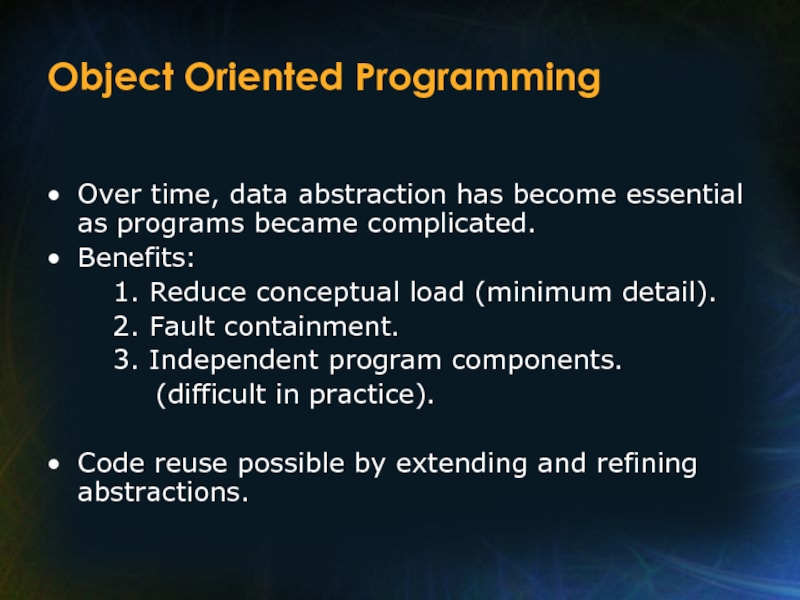
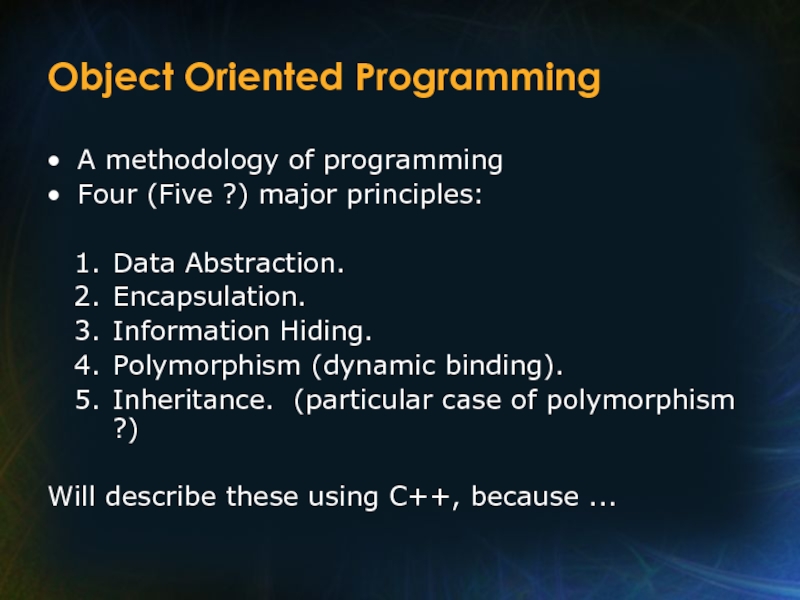
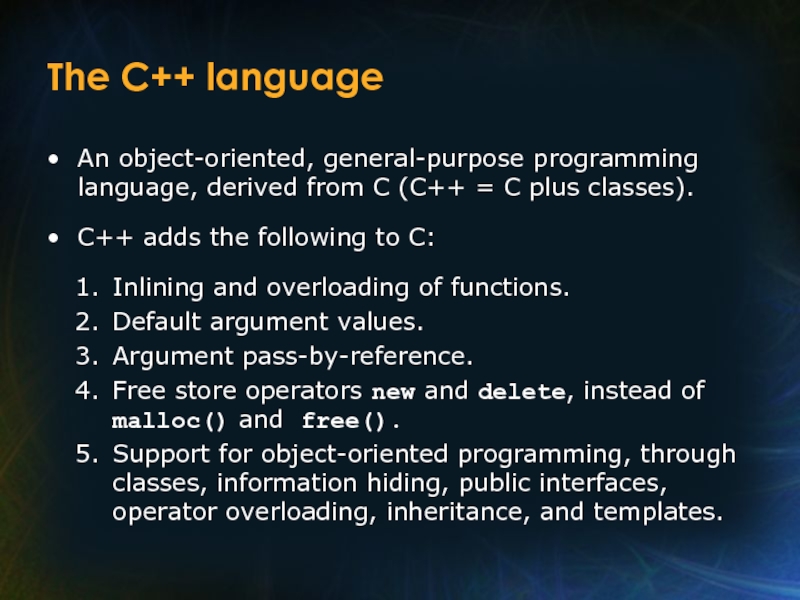
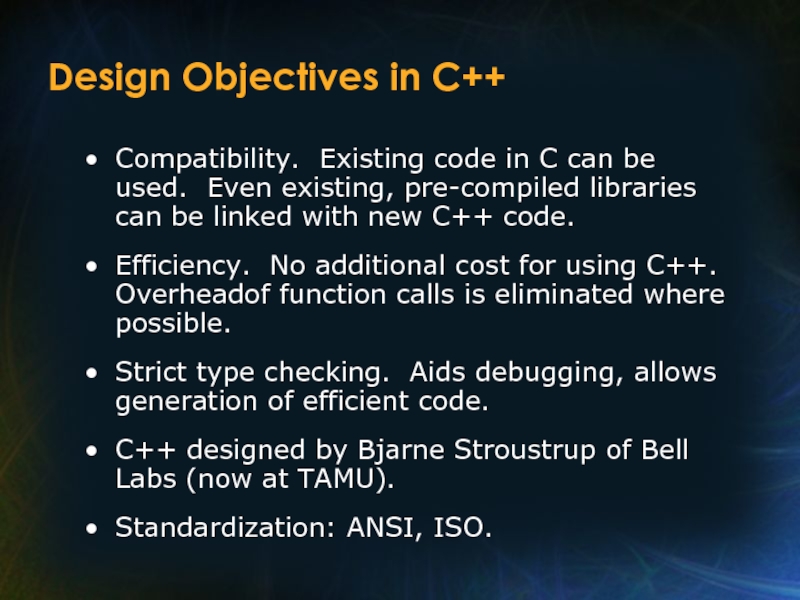


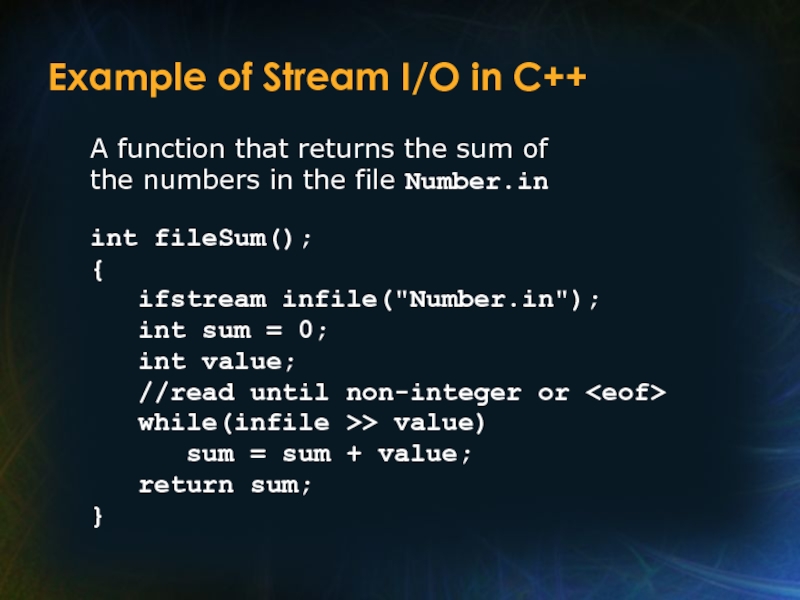
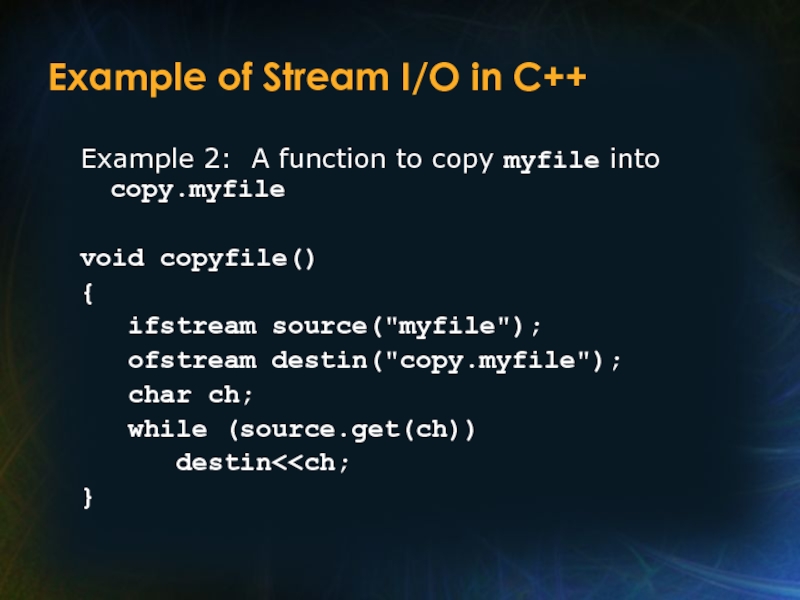
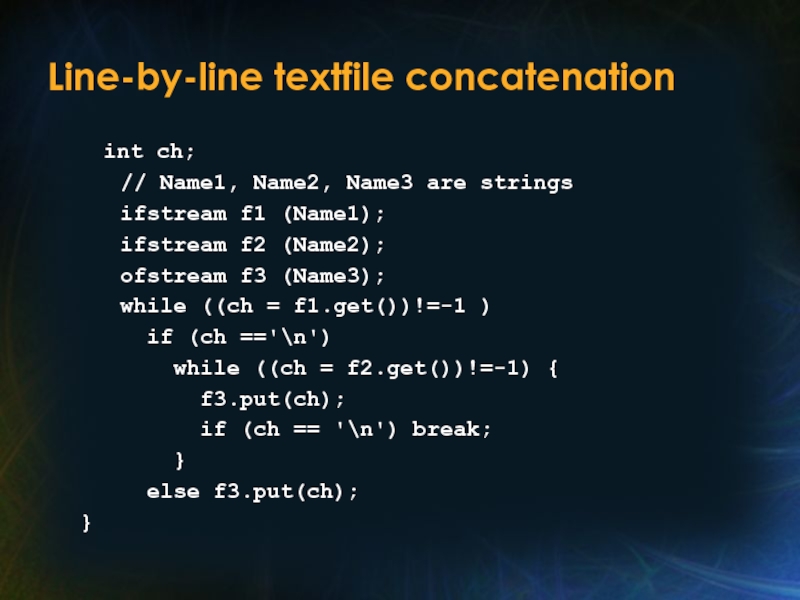
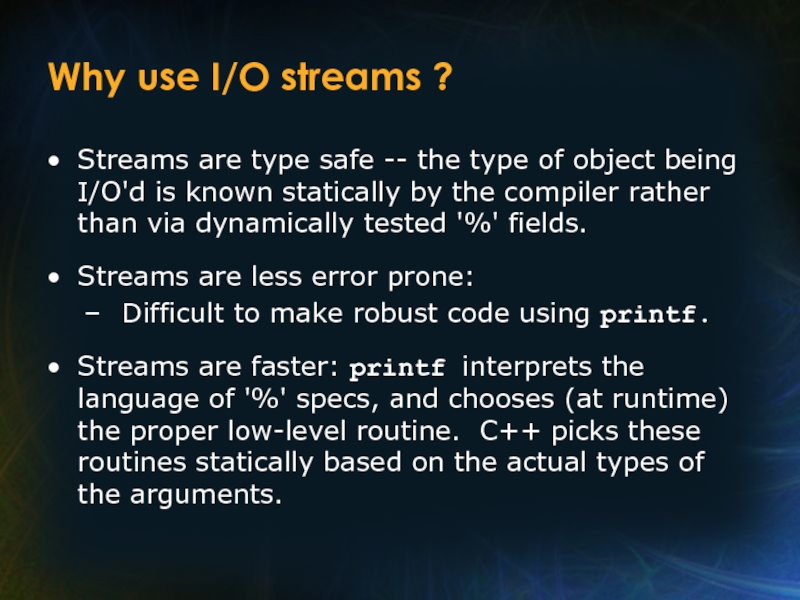




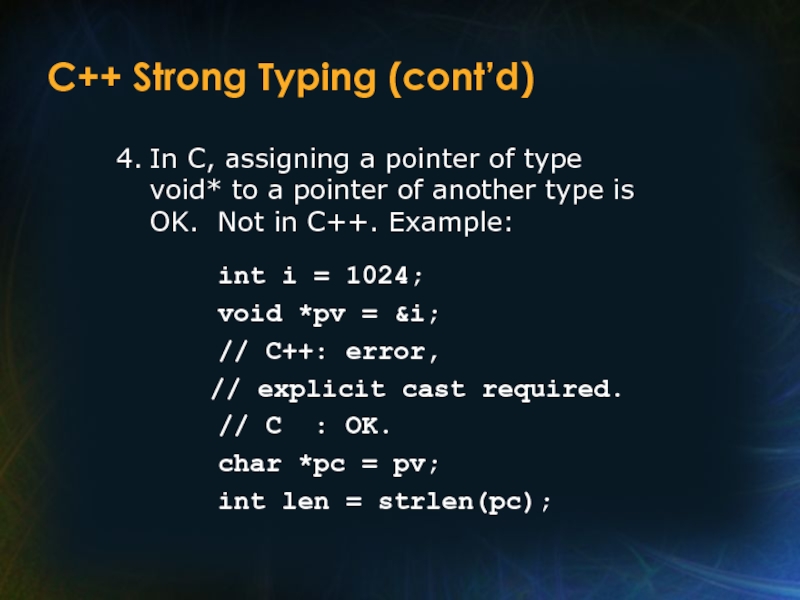
![C++ Strong Typing (cont’d)C++ is more careful about initializing arrays: Example: char A[2]=](/img/tmb/1/95059/cea4bfa6c7f82315ae86bfbd3a31f2bd-800x.jpg)
